Coat of arms of Charles V, Holy Roman Emperor facts for kids
Quick facts for kids Coat of arms of Charles V, Holy Roman Emperor |
|
|---|---|
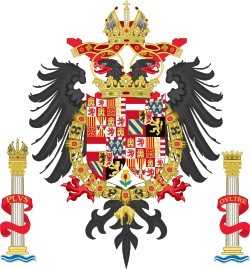 |
|
| Armiger | Charles V |
| Adopted | 1519 |
| Crest | Imperial Crown of the Holy Roman Empire |
| Torse | Cross of Burgundy |
| Blazon | His maternal inheritance quartering his paternal inheritance |
| Supporters | Imperial Eagle and the Pillars of Hercules |
| Motto | Plus Oultre (Latin translation: Plus Ultra) |
| Order(s) | Order of the Golden Fleece |
Charles V, Holy Roman Emperor was a very powerful ruler in Europe. He inherited land and titles from many important royal families. In 1506, he received the Burgundian Netherlands from his grandmother, Mary of Burgundy.
Then, in 1516, Charles became the king of Spain. He inherited these kingdoms from his grandparents, Isabella I of Castile and Ferdinand II of Aragon. They were known as the Catholic Monarchs. Finally, in 1519, his grandfather Maximilian I, Holy Roman Emperor passed away. Charles then inherited the Habsburg lands in central Europe. He was also chosen to be the Holy Roman Emperor.
Contents
Understanding Charles V's Coat of Arms
A Coat of Arms is like a special symbol or logo for a family, country, or ruler. It shows their history, lands, and titles. Charles V's coat of arms was very detailed. It showed all the different kingdoms and areas he ruled.
His "Greater Coat of Arms" was the most complete version. It proudly displayed all the lands and titles he had inherited.
What the Shield Shows
The main part of a coat of arms is the shield. Charles V's shield was divided into many sections. Each section represented a different kingdom or region he controlled.
- The top left and bottom right sections showed his Spanish lands. These included the Kingdom of Castile (a castle) and the Kingdom of León (a lion).
- These Spanish sections also included symbols for the Kingdom of Aragon and the Kingdom of Sicily. Later, symbols for Jerusalem, Naples, and Navarre were added.
- The top right and bottom left sections showed his Austrian and Burgundian lands. These included symbols for Austria, the Duchy of Burgundy, and the Duchy of Brabant.
- In the very center of these sections, there was a smaller shield. This smaller shield showed symbols for Flanders and Tyrol.
- At the very bottom of the main shield, there was a symbol for the Kingdom of Granada. This was a pomegranate fruit.
Other Important Parts
- Supporters: On either side of the shield, there were two figures holding it up. For Charles V, these were a two-headed eagle and the Pillars of Hercules. The Pillars of Hercules represented the Strait of Gibraltar. This was seen as the edge of the known world.
- Motto: Around the pillars, there was a motto: "PLUS ULTRA" or "PLUS OULTRE". This means "further beyond" in Latin or French. It showed Charles V's ambition to explore and expand.
- Crown: Above the shield was the Imperial Crown of the Holy Roman Empire. This showed his highest title.
- Order: The shield was often surrounded by the collar of the Order of the Golden Fleece. This was a special group of knights.
Features of the Coat of Arms
This section explains the different parts of Charles V's coat of arms in more detail.
The Burgundian Lands and the Golden FleeceIn 1477, the land of the Duchy of Burgundy was taken over by France. However, Mary of Burgundy, the last duke's only child, married Charles V's grandfather, Maximilian I, Holy Roman Emperor. This marriage gave the Habsburg family control of other important Burgundian areas. These included the Low Countries (like modern-day Belgium and Netherlands) and the County of Burgundy. Even though the main Duchy of Burgundy was lost, the Habsburgs kept the title of Duke of Burgundy. They often used the name "Burgundy" to refer to these lands until the late 1700s. Charles V was the leader of many knightly orders. But the Order of the Golden Fleece was the only one he regularly wore and gave to others. Images for kidsSee also
|
|||||||||||||||||||||||||||||||||||||||||||||||||||||||||||||||||||||||||||||||||||||||||||||||||||||||||


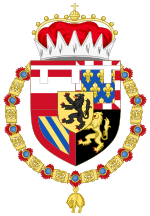
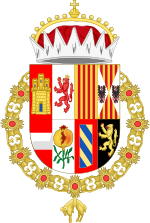

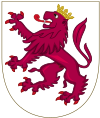

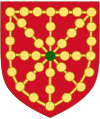
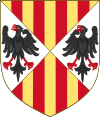
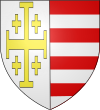
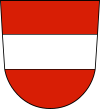
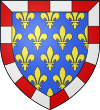

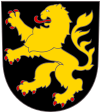
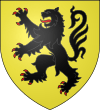

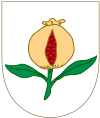
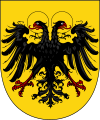

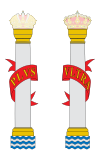

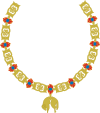
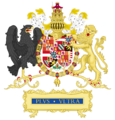
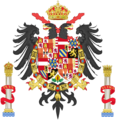

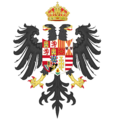



 In Spanish:
In Spanish: